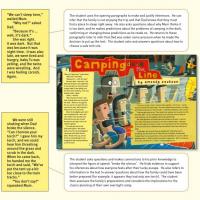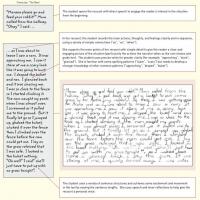By the end of year 4
The reading standard
The writing standard
The reading standard
By the end of year 4, students will read, respond to, and think critically about texts in order to meet the reading demands of the New Zealand Curriculum at level 2. Students will locate and evaluate information and ideas within texts appropriate to this level as they generate and answer questions to meet specific learning purposes across the curriculum.
Key characteristics of texts that students read at this level
The texts that students use to meet the reading demands of the curriculum at this level will often include:
- some abstract ideas that are clearly supported by concrete examples in the text or easily linked to the students’ prior knowledge
- some places where information and ideas are implicit and where students need to make inferences based on information that is easy to find because it is nearby in the text and there is little or no competing information
- a straightforward text structure, such as a structure that follows a recognisable and clear text form
- some compound and complex sentences, which may consist of two or three clauses
- some words and phrases that are ambiguous or unfamiliar to the students, the meaning of which is supported by the context or clarified by photographs, illustrations, diagrams, and/or written explanations
- other visual language features that support the ideas and information, for example, text boxes or maps
- figurative language, such as metaphors, similes, or personification.
Such texts will include both fiction and non-fiction in electronic and print media. They may be published individually, for example, as picture books, junior novels, multimedia resources, or junior reference materials, or they may appear in collections (for example, the School Journal often includes poems, plays, procedural texts, and information texts designed for this age group).
Illustrating the reading standard
'Camping down the Line' (School Journal, Part 2 Number 1, 2004)
Noun frequency level: 8.5–9.5
By the end of year 4, students are required to locate and evaluate the information and ideas within a variety of fiction and non-fiction texts, drawing on the knowledge and skills described in the Literacy Learning Progressions, to meet the reading demands of the curriculum. The curriculum tasks will often involve the students in generating their own questions as well as answering questions from the teacher.
The students and their teacher are planning an EOTC week as part of their health and physical education programme. The students need to identify both the risks associated with camping and the safety measures required to avoid those risks.
'Camping down the Line' is a humorous narrative describing a family’s dramatic experience. The story provides opportunities for the students to achieve specific learning outcomes in English, health, and physical education.
The teacher chose the text because the theme of the story (that campers need to prepare well and be safety conscious) supports the students’ learning in the context of outdoor education. The text requires them to locate and use implicit information to meet their reading purposes.
This example illustrates aspects of the task and text and demonstrates how a student engages with both task and text to meet the reading demands of the curriculum. A number of such examples would be used to inform the overall teacher judgment for this student.
Return to top
The writing standard
By the end of year 4, students will create texts in order to meet the writing demands of the New Zealand Curriculum at level 2. Students will use their writing to think about, record, and communicate experiences, ideas, and information to meet specific learning purposes across the curriculum.
Key characteristics of students' writing at this level
Students will write for a range of different purposes to meet the specific demands of the curriculum at this level, using a process appropriate to the task and drawing on the knowledge, skills, and attitudes that will help them achieve their purpose. The knowledge, skills, and attitudes expected at this level, including those needed for spelling and punctuation, are described in the Literacy Learning Progressions.
Students will independently write texts, using language and a simple text structure that suit their audience and purpose (for example, when recounting, describing, narrating, reporting, or explaining). These texts will include, when appropriate:
- content that is mostly relevant to the curriculum task, covers a range of ideas, experiences, or items of information, and often includes detail and/or comment supporting the main points
- mainly simple and compound sentences that vary in their beginnings,structures, and lengths and are mostly correct grammatically
- attempts at complex sentences
- words and phrases, in particular, nouns, verbs, adjectives, and adverbs, that clearly convey ideas, experiences, or information.
Illustrating the writing standard
‘The Ram’
By the end of year 4, students are required to create a variety of texts in order to think about, record, and communicate experiences, ideas, and information across the curriculum. To meet the standard, students draw on the knowledge, skills, and attitudes for writing described in the Literacy Learning Progressions for students at this level.
As part of their learning in English, the students in this year 4 class are writing to form and express ideas based on a significant personal experience. Each student is writing a recount of a scary experience that they think will interest and engage their audience.
This example illustrates aspects of the task and text and demonstrates how a student engages with both task and text to meet the writing demands of the curriculum. A number of such examples would be used to inform the overall teacher judgment for this student.
Published on: 19 Oct 2009
Return to top



